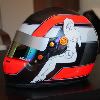Tim.Wright wrote:Classical roll theory predicts roll centres based purely on kinematic relationships and neglects all force elements (ie springs). This makes it a completely inadequate transfer function for predicting vertical compliance response (vertical displacement due to vertical force)
Consider this: If your rear springs are very soft (tending to zero stiffness) and the fronts are very hard (tending to rigid), then your "pitch centre" due to vertical load will be at the contact patch of front tyres, regardless of your suspension kinematics. This cannot be predicted by classical roll theory.
This theory is designed ONLY for lateral inputs, but even for this its not very accurate. Like any model though it can still be useful.
To investigate response to vertical forces, you really have no chance but to evaluate it from a force point of view.
Tim
Yes i agree, this is why i said both geometry and forces, such as downforce.
I don't like to use rules of thumb like roll center etc. I rather use fundamentals because honestly i don't have the experience like some of you here with the field of racing.
I was refering to forces though and degree of freedom.
You example there is correct and i don't see a disagreement with my proposition that the car is rolling about the splitter at certain speed due to external forces and geometry; which can apply longitudinally.
Let me get a diagram up for a simple straight forward demonstration.







